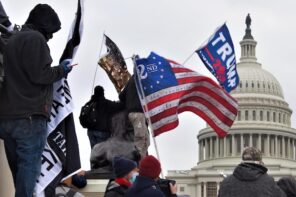Jesus asked him, “What is your name?” And he replied, “My name is Legion, because there are many of us inside this man”
(Mark 5: 9)
In the wake of the murders of nine African Americans at Emanuel AME church in Charleston on June 17 by a self-proclaimed white supremacist, there was a burst of media interest in the scale and scope of white supremacist groups and networks within the U.S.
What stands out in this recent media coverage, and in scholarship bearing upon both contemporary and historical trajectories of white supremacist movements, has been the tendency to view white supremacy—the idea that white people are inherently superior to people of color—as a relatively marginal or “extremist” dimension of American socio-religious culture.
I argue instead that white supremacy is a much more central part of American socio-religious culture than generally acknowledged and that its investigation cannot be limited to “lone wolf” racists such as the 21 year-old in Charleston—nor confined merely to networks of explicit white supremacist organizations and activists. Rather, behind the individually embodied form of white supremacist evil in the Charleston atrocity lay a much broader malevolent network—analogous to the numerously possessed demoniac man in the Gospel of Mark.
While white supremacist activity classified too broadly could result in attributing greater reach and influence to this worldview than it actually possesses within the U.S., identifying it only with a few outlier individuals and groups minimizes both the quality and the quantity of white supremacist ferment.
Explicit white supremacy gained a noticeable following beginning with the emergence of the Ku Klux Klan in the years following the Civil War. By the 1920s, as many as six million people across the U.S. were estimated to be members of the Klan and subscribers to its agenda of resisting black social progress through terror and a hate-mongering rhetoric centered upon white exceptionalism and black depravity. The American Nazi Party, birthed in the 1950s, and its various off-shoots over successive decades have also had a wide following, although their actual numbers have remained sketchy.
During the post-Civil Rights Movement period, a large number and variety of U.S.-based hate groups and “patriot” groups emerged, with known hate groups numbering 537 by the mid-1990s alongside 858 “patriot” groups (including militia groups, common law courts, and political or citizens groups) totaling more than a million members. Also by the mid-1990s there were reported to be more than 2,000 hate group web sites, 150,000 to 200,000 subscribers to racist publications, approximately 100 operative telephone hate-lines, and one hundred fifty independent racist radio and television shows airing weekly to millions of sympathizers.
With the dramatic expansion over the last two decades of internet coverage and of cable and satellite media outlets, electronic access to hate group and white supremacist group content has skyrocketed—even as the numbers of those groups have themselves noticeably increased. For example, the number of known hate groups is reported to have increased from roughly 600 in the year 2000 to 930 in 2014.
Moreover, major television networks such as Fox TV have ushered hate content and white supremacist content into the media mainstream, featuring racialized rhetoric that ranges from disparagement of blacks to harsher forms of racist venom—as in the case of frequent guest, Ted Nugent, who said of undocumented immigrants “I’d like to shoot them dead” and who publicly proclaims “working hard, playing hard…white shit kickers” as the “real” Americans.
Fox talk shows reach tens of millions of persons on a weekly if not daily basis, and while the commentary on Fox may not be always explicitly white supremacist in nature, it often embodies a cloaked racial chauvinism.
It is the cloaked versions of white supremacist constructions (in the form of racially-coded hate-mongering) that must be taken into account when assessing the scale and scope of white supremacist operations within this country. These cloaked narratives are frequently rehearsed by right-leaning mainstream leaders who troll for political support from across the right-wing spectrum, emboldening the racist right in the process while signaling a willingness to provide sympathetic if not surrogate leadership on behalf of white racist objectives. These surrogates and sympathizers have included a host of contemporary Republican elected officials who have openly campaigned in white racist venues, welcomed their campaign contributions, and symbolically and sometimes substantively embraced white racial tyranny.
Ronald Reagan often is cited in this regard, who, as the Republican presidential nominee in 1980, launched his general election campaign with a speech on “states rights” in Philadelphia, Miss.—the national headquarters at the time of the Ku Klux Klan and the place where three civil rights activists were murdered in 1964 while investigating black church burnings. The coded message could not have been clearer—“states rights” was the rallying cry of the confederacy, intent as it was on maintaining the right of whites to enslave blacks, and Philadelphia, Miss., was the infamous place where 100 years later whites provided high-profile confirmation of their ongoing willingness to shed blood to maintain brutal oppression of blacks.
Beyond Reagan, other Republican presidential candidates signaled racist sympathies through, for example, routine campaign stops at Bob Jones University, a fundamentalist Christian college in South Carolina that barred black enrollment until 1971. The university also prohibited interracial dating (thereby connecting itself to murderous traditions of white preservation against black defilement) and only rescinded the policy in the year 2000 when George W. Bush’s campaign visit to the university brought long-overdue national attention to this Republican callousness.
More recently, three Republican senators, Ted Cruz, Rand Paul, and Rick Santorum (all currently running for US president) received campaign donations during the last several years from the head of the Council of Conservative Citizens, a white supremacist group reported to have served as an inspiration for the 21-year-old white supremacist arrested for the nine murders at Emanuel A.M.E. church in Charleston.
By exposing connections between explicit white supremacist views and what have been broader and often cloaked white essentialist narratives, a fuller picture emerges of white supremacist mindscapes and landscapes within the U.S.
Defending Slavery with Religion
These white essentialist narratives within the U.S. actually trace back to colonial New England, where Puritan colonists operated with a very narrowly construed understanding of who possessed settler and legal rights. Although this mainly took the form of religious intolerance of everyone who was not Congregationalist, the primary emphasis on religious rather than racial markers resulted from the degree to which the religious space, especially during the 1600s, was contested within New England.
Race prejudice was just as real but far less contested due to the fact that it represented a struggle not between relative social equals (as in the case of religious contestation between white Protestants factions) but, rather, between white colonial forces and their subjugated African and Native American contemporaries who were considered “inferiors.” And as historian Perry Miller notes, “encroachments, especially of inferior upon superior” were “never seriously called in question” in New England before 1730.
Even in 1730, if anything was called into question it was class distinction—because no serious challenges of race orthodoxies would gain strength until the onset of the abolitionist movement in the late 1700s.
The combining of racially implicit Puritan essentialist doctrines with southern racial hierarchical ideas paved the way for much harder forms of race ontologies within the slave South during the 19th century. With abolitionism gaining momentum in the early 1800s, the slavocracy—with southern clergy in the forefront—responded with a variety of defenses of slavery. One of the more prevalent defenses was to argue, in characteristically Calvinistic terms, that social station is predetermined by God.
According to 19th century pro-slavery advocates of this position, whites, on their part, were divinely-entrusted with superior qualities necessary for carrying out a range of Godly purposes, with the purpose most often cited being that of Christianizing and civilizing the benighted slaves. Typical of this genre were views expressed by a Methodist minister in North Carolina, Washington S. Chaffin who asserted, nature has “drawn lines of demarcation between (blacks) and (whites) that no physical, mental or religious cultivation can obliterate.”
Because of what he considered to be a tendency by blacks toward “barbarism,” Chaffin believed that blacks “required the continual supervision of the white man to hold him in check.” The consequence of enslavement, he said, was that slaves were provided with conditions “more conducive to his happiness than any other the African has ever known.”
The same kind of moral superiority of white slaveholders and moral deficiency of slaves was articulated in a 1978 publication by Rousas John Rushdoony, a prominent representative of the new “Christian scholarship” popular among contemporary white evangelicals. He writes:
“Granted that some Negroes were mistreated as slaves, the fact still remains that nowhere in all history or in the world today has the Negro been better off. The life expectancy of the Negro increased when he was transported to America. He was not taken from freedom into slavery, but from a vicious slavery to degenerate chiefs to a generally benevolent slavery in the United States.”
While clergy were among the leading proponents of 19th-century white supremacy, the 20th century witnessed the coming-of-age of an assortment of rank-and-file white supremacists. The emergence of many of these groups paralleled the galvanization of desegregationist and anti-racist forces from the mid-century forward.
A group regarded by advocates and critics alike as the ideological backbone of the contemporary white supremacist movement is “Christian Identity,” which asserts “White, Anglo-Saxon, Germanic and kindred people [are] God’s true, literal Children of Israel” and that all non-white peoples (with emphasis here on Jews and blacks) are part of a demonic “seed line” intent upon destroying the chosen white seed line.”
Christian Identity is regarded by close observers of this activity as having revitalized and unified the far right.
The condemnation publicly expressed toward the 21-year-old charged with the racially-motivated murders in Charleston, while providing reassurance about America’s growing consensus against racial tyranny, is still a far cry from condemnation of white supremacy and racial tyranny in all its explicit and implicit forms.
Although the murderous actions in Charleston were committed by an individual, these actions were rooted in much broader white supremacist mindscapes and landscapes. As North Carolina NAACP President William Barber pithily observed after the arrest of the 21-year-old murderer:
“The perpetrator is caught, but the killer is still at large.”
By now, most Americans likely are aware of the name of the accused in the Charleston murders. I choose, however, not to speak it so as not to individualize his evil nor divert attention from the larger configuration of evil of which he is part.
But if we were to call him by name—it would be “Legion.”





